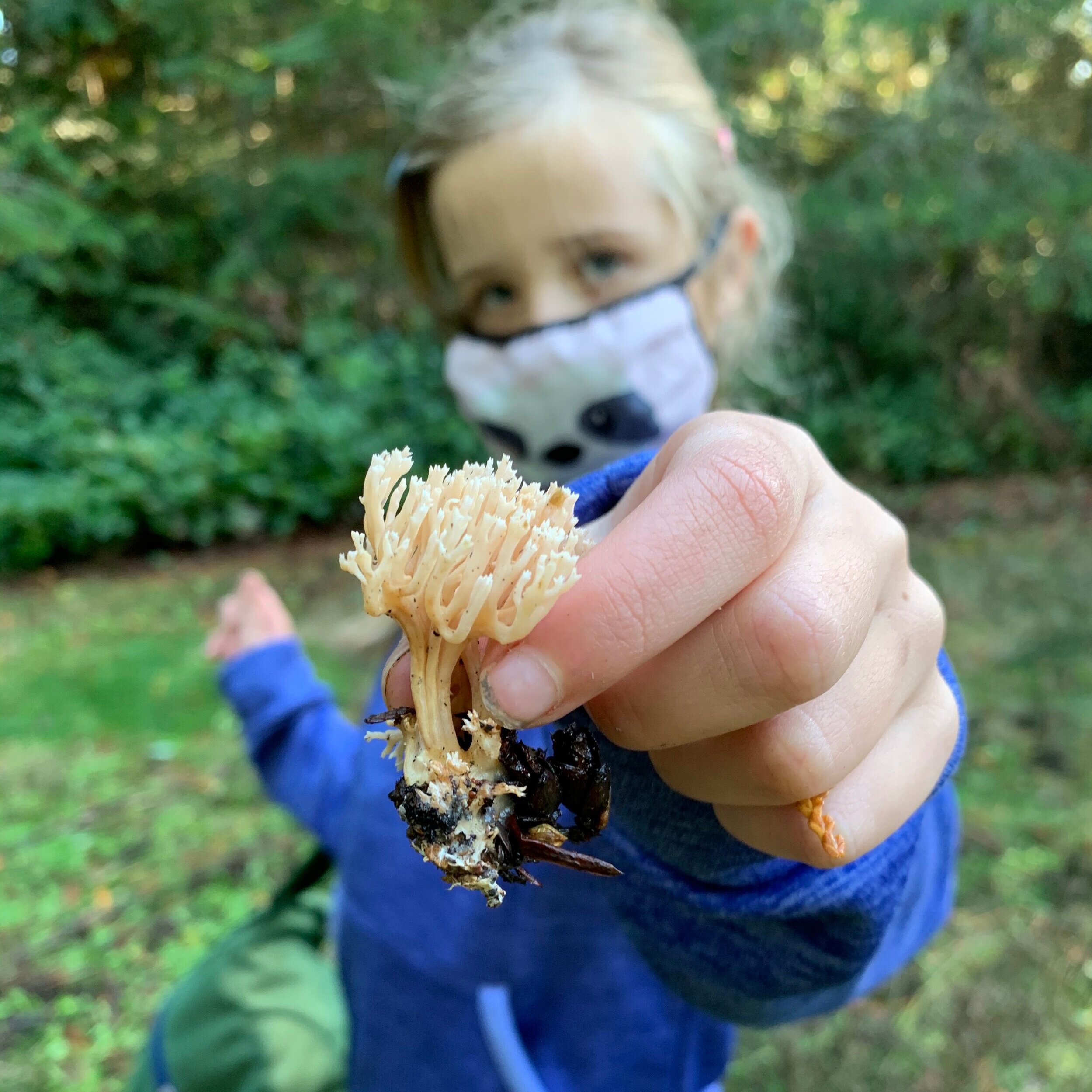Mushrooms, Magic and Mystery Revealed
September 23, 2021
The PNW is a haven for mushrooms; our cool and moist growing conditions mean you can find mushrooms just about anytime of year, especially in late Summer into early Fall. This is great news as mushrooms are a delicious and medicinal gift from nature. Learning to positively identify and eat wild mushrooms can be tricky business, and requires more in-depth study beyond the scope of this article. However, here is some basic information to get you started.
Anatomy
The fleshy mushroom you usually find above ground is the reproductive part the organism (akin to the fruit of a tree). The actual main body of the organism is underground (or inside rotting wood) and is constructed of fine threadlike strings. As they grow, the mycelia branch off forming extensive networks, called mycelium, that resemble the roots of a tree. And like tree roots, the mycelium spread out into the soil in search of nutrients.
Some mycelium can be quite large! A form of honey fungus found in the forests of Michigan is estimated to cover over 40 acres; the Armillaria ostoyae fungus discovered in our own state of Washington was found to cover at least 1500 acres; and Oregon currently boasts the largest reaching mycelium network at 2,384 acres! According to Ken Russell, a forest pathologist at the State Department of Natural Resources, if left unchecked, fungus can double in size in 20 years. Many large networks the size of those named here are often thousands of years old!
The structure of a typical gilled mushroom includes a cap, gills, and a stalk. The gills produce spores, the single-celled reproductive aspect of the mushroom.
Habitat
Mushrooms are found in many different locations including: woodlands, forest, pastures, meadows, burned areas, lawns, gardens, manure piles, snow banks, and even sandy deserts!
Many delicious edible wild mushrooms grow in association with specific types of trees. Getting to know these groupings can help you identify them:
Pine: King boletus (Boletus edulis), Hedgehog mushroom (Dentinum repandum), Masutake (Armillaria ponderosa)
Western Hemlock: Admirable Boletus (Boletus mirabilis)
Oak: Chanterelles (Cantharellus cibarius), Blewits (Clitocybe nuda)
Aspen, Poplar and Willow: Oyster Mushroom (Pleurotus ostreatus), Honey mushrooms (Armillariella mellea)
Identifying Wild Mushrooms
It’s important to observe mushrooms closely, and carefully, and check with at least two good wild mushroom field guides when identifying your next fungus snack. Here are some basic do’s and don’ts to follow:
DO:
Always use more than one field guide to positively confirm your identification
Take your time, and methodically check the mushroom’s features
Be careful and respectful
Practice sustainable harvesting: collect only a 1/4 of the mushrooms you find, leaving plenty for the animals that eat them, and allowing the mushrooms a chance to reproduce
DON’T:
Don’t assume that if another animal can eat it (including other humans) that it is safe for you to do so.
Don't use other people's anecdotal tales to identify an edible mushroom
Don’t let fear prevent you from exploring this fascinating world of wild edible mushrooms!
Wild Edible Mushrooms of the PNW
There are many more than you think. Here’s a list to peak your taste buds:
apricot jelly mushroom
bear's head tooth mushroom
black morel
blue chanterelle
cauliflower mushroom
chicken of the woods
comb tooth mushroom
common puffball
fairy ring mushroom
golden chanterelle (aka chanterelle)
hedgehog mushroom
hexagonal-pored polypore
horn of plenty (aka black chanterelle, black trumpet)
horse mushroom
ink cap
jelly ear (aka wood ear)
king bolete (aka cepe)
larch bolete
lion's mane
lobster mushroom
meadow mushroom
mica cap
oyster mushroom
red cracked bolete
rosy gomphidius
saffron milk cap
scaly hedgehog
shaggy mane
slimy spike cap
western giant puffball
yellow swamp russula
yellow-gilled russula
Hunting for Golden Chanterelles
Often a favorite among chefs and lay-people alike, Golden Chanterelle (Cantharellus cibarius) is known for its aromatic, fleshy, mild taste. Often found growing in groups on forest floors, beneath salal, ferns, and moss, this flowery-shaped beauty has some unique features.
For starters, the cap is fleshy, with wavy, rounded margins that taper downward to meet the stem. The gills are not typical, rather forming rounded, blunt, shallow, widely spaced ridges. At the edge of the cap they are forked and interconnected. The Chanterelle's aroma resembles an apricot or peach. It’s golden on the outside, and when you pick it apart (it should tear it open like a chicken breast), you’ll see white on the inside.
Chanterelles typically grow in pairs, with one growing up and maturing a little ahead of the second. This is a great strategy to help spread spores and colonize an area. When harvesting Chanterelles, be sure to leave the “younger” one to mature.
Marinated Chanterelles
Serves 8 as an appetizer or heated and drained to serve over pasta.
1 cup peanut oil or light olive oil
1 pound chanterelles, cut into large slices (make sure they are dry--waterlogged mushrooms won't work)
Marinade:1/4 cup fine wine vinegar, balsamic or fruit vinegar
1 garlic clove, sliced thin
1 bay leaf
1 teaspoon Dijon mustard
Pinch of fresh herbs (tarragon, savory, oregano, or marjoram)
1/4 teaspoon salt
In a sauté pan or skillet, heat the oil until it becomes very hot, then add the chanterelles. Toss them in the pan quickly for 3 to 5 minutes. Combine all the marinade ingredients. Add the chanterelles and the oil from the pan. Marinate the mushrooms for at least 4 hours in the refrigerator. This will keep for 2 weeks in the refrigerator.
Enjoy!

